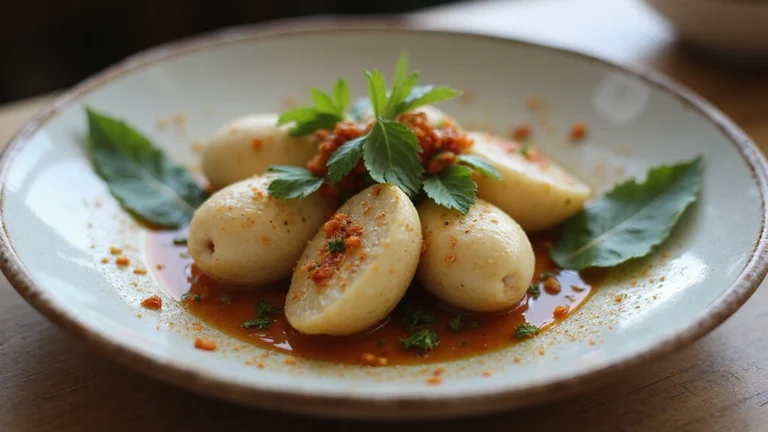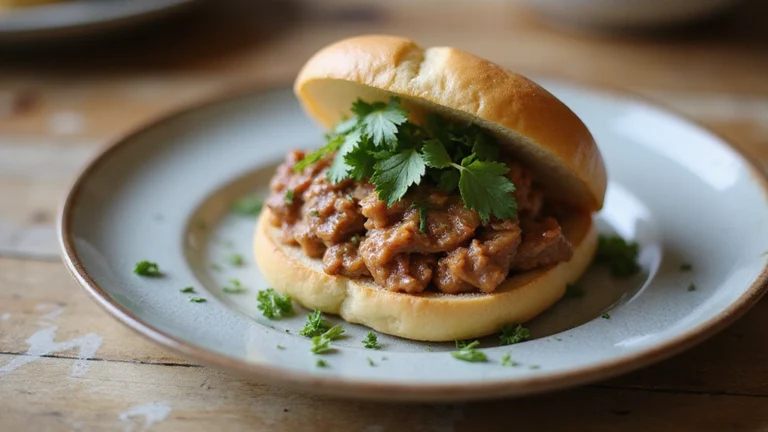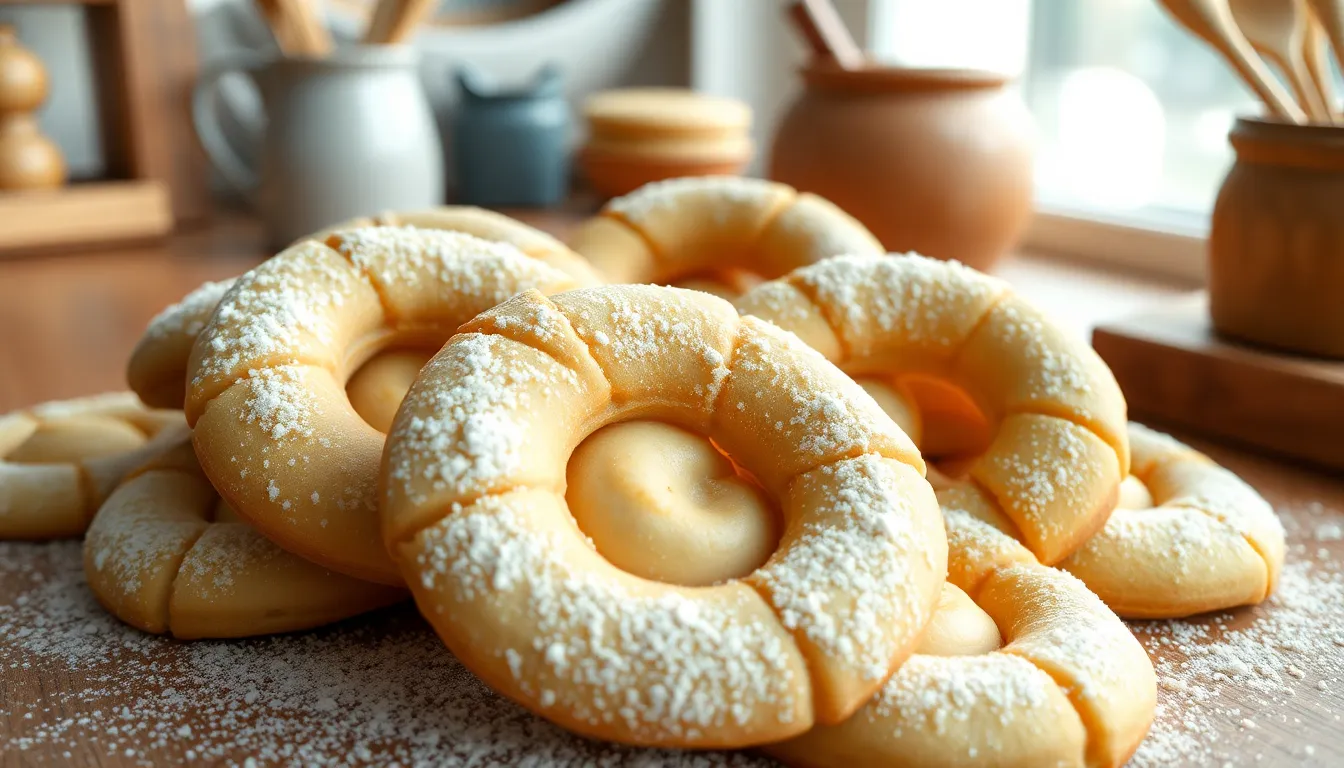
Have you ever tasted the buttery, almond-infused delight of authentic Dutch almond cookies? These crisp yet tender treats will transport your taste buds straight to the charming bakeries of Amsterdam.
These beloved Dutch almond cookies, also known as “Amandelkoekjes,” have been a staple in Dutch households for generations. Their perfect balance of sweet almond flavor and delicate crumbly texture makes them irresistible with afternoon tea or coffee. What makes these cookies truly special is their simplicity—just a handful of quality ingredients transforms into something extraordinary.
You’ll be amazed at how quickly these cookies come together. With their distinctive crescent shape and light dusting of powdered sugar, they’re as beautiful as they are delicious. Whether you’re exploring Dutch baking traditions or simply craving something uniquely sweet, these almond-packed treats deserve a spot in your recipe collection.
What Are Dutch Almond Cookies?
Dutch almond cookies or “Amandelkoekjes” are traditional Dutch treats that feature ground almonds as their star ingredient. These delightful cookies have a distinctive crumbly yet tender texture that practically melts in your mouth with each bite.
The authentic recipe calls for simple ingredients that work together to create a rich almond flavor profile. Unlike other almond cookies you might have tried before Dutch almond cookies maintain a perfect balance between sweetness and nuttiness without being overpowering.
These cookies typically come in various shapes including crescents half-moons or simple rounds. Most traditional versions feature a generous dusting of powdered sugar that creates a beautiful snowy appearance. Many Dutch families have their own variations passed down through generations making small adjustments to the base recipe.
What makes these cookies truly special is their versatility. They’re substantial enough to enjoy with coffee yet delicate enough to serve at formal gatherings. The concentrated almond flavor comes from both almond extract and ground almonds giving them an aromatic quality that distinguishes them from other European butter cookies.
During the holiday season these cookies become particularly popular throughout the Netherlands. You’ll find them featured prominently at Christmas markets and family celebrations where they’re often arranged in decorative tins as gifts. Their relatively long shelf life makes them perfect for preparing ahead of time for special occasions.
Why You’ll Love These Traditional Dutch Treats
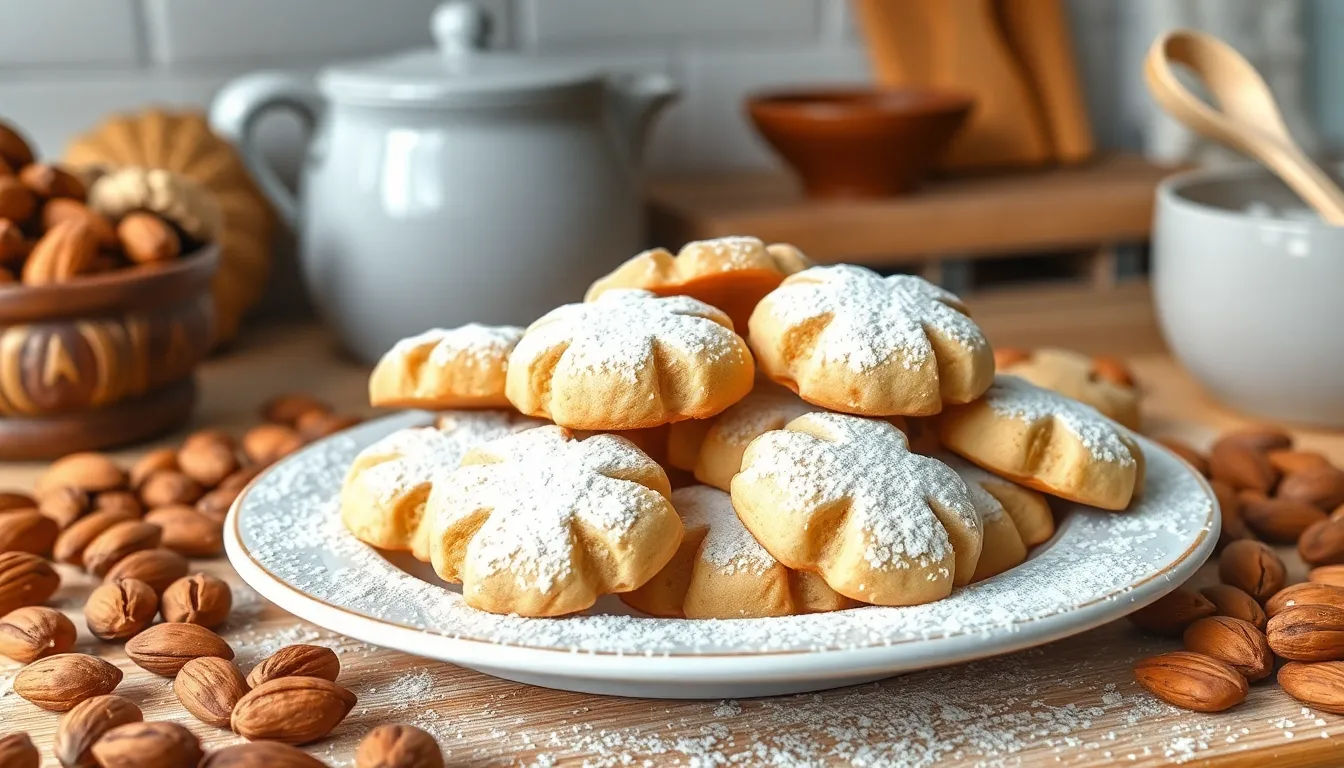
These Dutch almond cookies will instantly become a favorite in your recipe collection for countless reasons. Their incredible texture strikes the perfect balance between crisp edges and tender centers that literally melt in your mouth with each bite.
The simplicity of preparation makes these treats accessible to bakers of all skill levels. You can whip up a batch in under 30 minutes with just a handful of pantry staples yet the results taste like you spent hours in the kitchen.
Your kitchen will fill with an intoxicating aroma of almonds and butter as these cookies bake. The scent alone is enough to draw family members from all corners of the house to investigate what’s creating such a delightful fragrance.
The versatility of these cookies makes them suitable for any occasion. Serve them alongside afternoon coffee for an elevated everyday treat or package them beautifully for holiday gifts that recipients will treasure.
Unlike overly sweet desserts that can overwhelm the palate these cookies offer a sophisticated flavor profile where the natural nuttiness of almonds takes center stage. The light dusting of powdered sugar provides just enough sweetness without masking the star ingredient.
These treats also store exceptionally well maintaining their quality for up to two weeks when properly stored. This makes them perfect for preparing ahead of time for gatherings or keeping on hand for unexpected guests.
Health-conscious bakers will appreciate that these cookies contain nutritious almonds which provide protein healthy fats and vitamin E. While still a treat they offer more nutritional value than many other cookie options.
Cultural authenticity shines through in every bite allowing you to experience a true taste of Dutch baking tradition without leaving your kitchen. Each cookie connects you to generations of Dutch bakers who have perfected this recipe over centuries.
Equipment Needed

Creating these traditional Dutch almond cookies requires minimal equipment making them accessible for bakers of all experience levels. Gather these basic kitchen tools before starting your baking adventure:
- Mixing bowls (one medium-sized for dry ingredients and one large for the main dough)
- Electric mixer or stand mixer with paddle attachment
- Measuring cups and spoons for precise ingredient portions
- Rubber spatula for scraping down bowl sides
- Baking sheets (preferably light-colored aluminum)
- Parchment paper or silicone baking mats
- Cookie scoop or tablespoon for uniform cookie portions
- Wire cooling racks
- Small sifter or fine-mesh strainer for dusting powdered sugar
- Kitchen scale (optional but helpful for precise measurements)
Your baking sheets should be ungreased but lined with parchment paper or silicone mats to prevent sticking and ensure even baking. Position your oven racks in the middle position before preheating to promote consistent heat distribution throughout the baking process.
These Dutch almond cookies spread slightly during baking so leave about 2 inches between each portion of dough on your prepared sheets. Standard home ovens work perfectly for this recipe though convection settings should be avoided as the fan circulation can cause uneven baking with these delicate cookies.
Ingredients
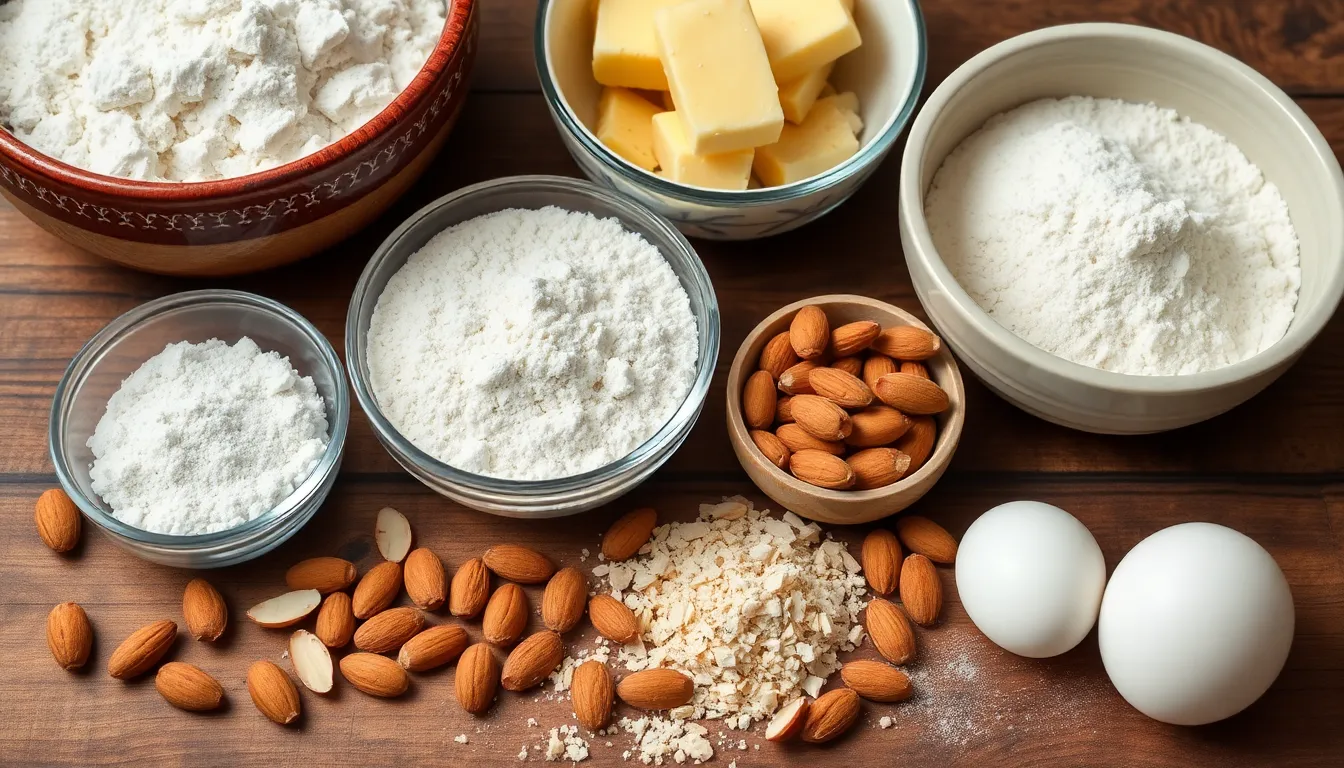
These authentic Dutch almond cookies require simple pantry staples that combine to create their distinctive flavor and texture. Here’s everything you’ll need to prepare these delightful treats.
For The Cookie Dough
- 2 cups (250g) all-purpose flour
- 1 cup (226g) unsalted butter, softened to room temperature
- 3/4 cup (150g) granulated sugar
- 1/2 teaspoon salt
- 1 large egg
- 1 teaspoon vanilla extract
- 1 teaspoon almond extract
- 1 cup (100g) finely ground almonds or almond flour
- 1/4 teaspoon baking powder
For The Almond Topping
- 1/3 cup (40g) sliced almonds
- 1 egg white, lightly beaten
- 2 tablespoons granulated sugar
- 1/2 cup (60g) powdered sugar for dusting after baking
How To Make Dutch Almond Cookies
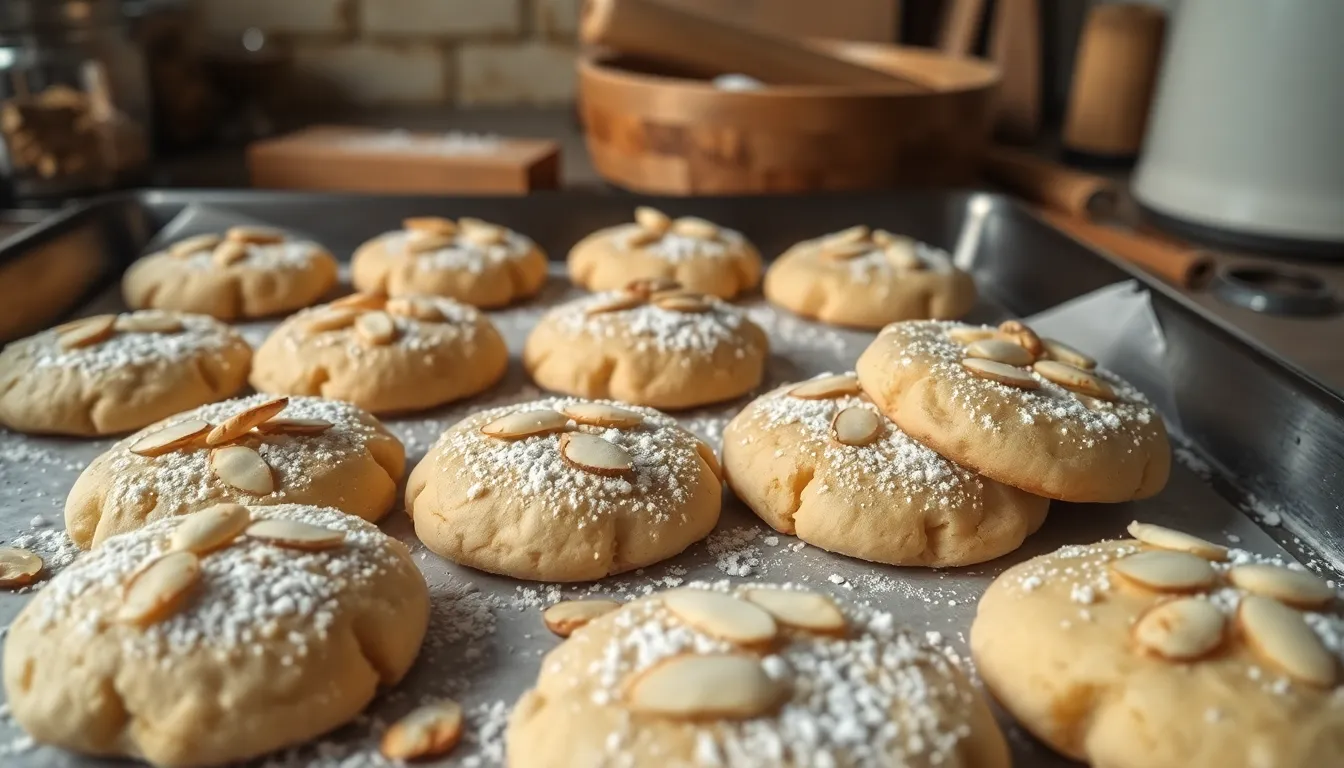
Creating these traditional Dutch treats is surprisingly simple and rewarding. Follow these step-by-step instructions to achieve perfect amandelkoekjes with their signature texture and almond flavor.
Preparing The Dough
Start by combining 2 cups of all-purpose flour and 1 teaspoon of baking powder in a medium bowl, then set aside. In a larger mixing bowl, cream together 1 cup of unsalted butter (softened) and ¾ cup of granulated sugar until light and fluffy, about 3-4 minutes using an electric mixer on medium speed. Add 1 egg and beat until fully incorporated. Pour in 1 teaspoon of vanilla extract and 1½ teaspoons of almond extract, mixing until combined. Gradually fold in 1 cup of finely ground almonds, ensuring they’re evenly distributed throughout the mixture. Add the flour mixture to the wet ingredients in two batches, mixing on low speed just until combined. Avoid overmixing as this can result in tough cookies. The dough should be somewhat soft but firm enough to handle. Cover the bowl with plastic wrap and refrigerate for 30 minutes to make the dough easier to work with.
Shaping The Cookies
Preheat your oven to 350°F (175°C) and line your baking sheets with parchment paper. Remove the chilled dough from the refrigerator. Using a cookie scoop or tablespoon, portion out the dough into 1-inch balls. Roll each portion between your palms to create smooth balls. Place them on the prepared baking sheets, leaving about 2 inches between each cookie to allow for spreading. For traditional Dutch almond cookies, gently press down on each ball with the palm of your hand to create a slight flattening – they should be about ½ inch thick. For crescent shapes, roll the dough portions into 2-inch logs and gently curve them. You can also use cookie cutters for more decorative shapes if desired.
Adding The Almond Topping
Prepare the almond topping by lightly beating 1 egg white in a small bowl. Brush the top of each cookie with this egg wash. Sprinkle about ½ cup of sliced almonds over the cookies, gently pressing them into the dough to ensure they stick. For an extra touch of sweetness, mix 3 tablespoons of granulated sugar with ¼ teaspoon of cinnamon and sprinkle this mixture over the almond-topped cookies. This step creates the characteristic crunchy, caramelized almond topping that Dutch almond cookies are known for. The egg wash helps the almonds adhere during baking while adding a beautiful golden sheen to the finished cookies.
Baking To Perfection
Place the cookie sheets in the middle rack of your preheated oven. Bake for 12-15 minutes, until the edges turn a light golden brown while the centers remain slightly soft. Keep a close eye on them after the 10-minute mark as they can brown quickly due to their high butter and almond content. Remove from the oven and allow the cookies to cool on the baking sheets for 5 minutes. The cookies will be very fragile when hot. Transfer them carefully to a wire rack to cool completely. Once cooled, dust generously with powdered sugar using a fine-mesh sieve. Store your Dutch almond cookies in an airtight container at room temperature for up to 1 week, or freeze for up to 3 months. The flavor actually improves after a day as the almond notes develop further.
Tips For The Best Dutch Almond Cookies
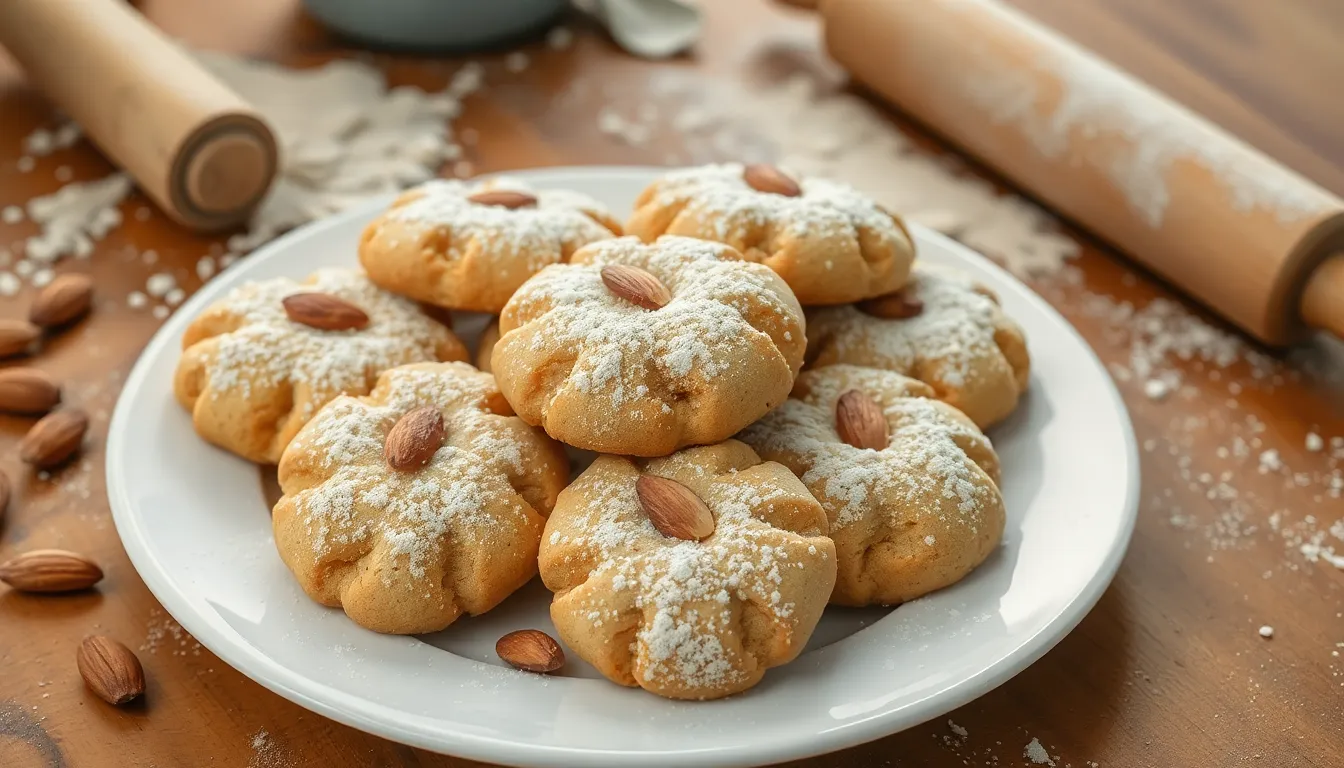
Quality Ingredients Matter
Use high-quality almond extract for authentic flavor. The difference between standard and premium extract dramatically impacts the final taste of your Amandelkoekjes. Opt for European butter with higher fat content to achieve that rich buttery taste traditional Dutch cookies are known for. Freshly ground almonds provide better texture and flavor than pre-packaged varieties that might have been sitting on store shelves for months.
Proper Butter Handling
Ensure your butter is at room temperature before beginning. Cold butter won’t cream properly with sugar creating a less than ideal texture. Test by pressing your finger lightly into the butter – it should make an impression without sinking in completely. Allow 30-45 minutes for refrigerated butter to reach optimal temperature depending on your kitchen’s climate.
Dough Consistency
Avoid overmixing the dough after adding flour. Mix just until ingredients are combined to prevent tough cookies. The perfect dough should be slightly sticky but manageable. If your dough feels too wet add flour one tablespoon at a time. For dough that’s too dry incorporate a teaspoon of milk until workable.
Chilling Technique
Chill the dough for at least 30 minutes before shaping. This step solidifies the fats preventing excessive spreading during baking. For even better results refrigerate the shaped cookies for 15 minutes before baking. Extended chilling develops deeper flavor profiles typical of authentic Dutch almond cookies.
Shaping Secrets
Use lightly floured hands when rolling dough to prevent sticking. For perfectly uniform cookies use a small cookie scoop (about 1 tablespoon capacity). Press sliced almonds gently but firmly onto the tops to ensure they adhere during baking. Traditional crescent shapes should be formed with tapered ends for authentic presentation.
Baking Precision
Watch cookies carefully during the last few minutes of baking. They should have light golden edges while remaining pale on top. Rotate baking sheets halfway through cooking time for even browning. Every oven varies so adjust baking times according to your exact appliance rather than relying solely on the recipe timeframe.
Perfect Finishing Touches
Apply powdered sugar while cookies are still slightly warm for better adhesion. For a professional look use a fine mesh strainer to dust the sugar evenly. Consider adding a hint of ground cinnamon to your powdered sugar for a subtle flavor enhancement. Allow cookies to cool completely before stacking or storing to preserve their delicate texture.
Storage And Freezing Instructions

Dutch almond cookies maintain their exceptional quality when stored properly. Place completely cooled cookies in an airtight container at room temperature for up to 7 days. Separate layers with parchment paper to prevent them from sticking together and losing their delicate texture. These Amandelkoekjes actually improve in flavor after the first day as the almond notes continue to develop.
For longer storage freeze these cookies for up to 3 months. Arrange the fully cooled cookies in a single layer on a baking sheet and freeze until solid about 1 hour. Transfer the frozen cookies to freezer-safe containers or heavy-duty freezer bags adding parchment paper between layers. Label each container with the date to track freshness.
When ready to enjoy thaw frozen Dutch almond cookies at room temperature for 2-3 hours. You can refresh them by warming in a 300°F oven for 3-5 minutes which reactivates their buttery aroma and restores their delightful texture. Dust with fresh powdered sugar after reheating for that just-baked appearance.
Make these cookies ahead for special occasions or holiday gift-giving. The dough itself can also be frozen for up to 2 months—simply shape into a disc wrap tightly in plastic wrap and place in a freezer bag. Thaw the dough overnight in the refrigerator before rolling and baking according to the recipe instructions.
Variations To Try

While traditional Dutch almond cookies are delicious on their own, these versatile treats can be customized to suit different tastes and occasions. Here are some exciting variations that build on the classic recipe while maintaining the authentic almond character.
Chocolate-Dipped Dutch Almond Cookies
Transform your traditional Dutch almond cookies into an indulgent treat by dipping them in chocolate. After your cookies have completely cooled, melt 8 ounces of high-quality dark, milk, or white chocolate in a double boiler or microwave in 30-second intervals. Dip half of each cookie into the melted chocolate and place on parchment paper to set. For added texture, sprinkle the wet chocolate with crushed almonds, sea salt, or colorful sprinkles before it hardens. These elegant chocolate-dipped versions make perfect gifts during the holidays and provide a wonderful contrast between the nutty cookie and rich chocolate coating. Store them in a cool place to prevent the chocolate from melting.
Spiced Dutch Almond Cookies
Add warming spices to your Dutch almond cookies for a cozy twist perfect for fall and winter. Incorporate 1 teaspoon of ground cinnamon, 1/4 teaspoon of ground nutmeg, and a pinch of ground cloves to your dry ingredients before mixing. This spice combination complements the almond flavor beautifully and creates an aromatic cookie that pairs wonderfully with coffee or hot chocolate. You can also experiment with cardamom, ginger, or even a touch of black pepper for more exotic flavor profiles. Roll the shaped cookies in a cinnamon-sugar mixture before baking for an extra spiced coating that creates a delightful crust. These spiced variations evoke the feeling of traditional European Christmas markets and make your kitchen smell amazing.
Serving Suggestions

Dutch almond cookies shine as versatile treats that can elevate various occasions and complement many beverages. Serve these delicate cookies on a decorative platter for afternoon tea gatherings alongside a pot of Earl Grey or chamomile tea. Their buttery almond flavor pairs exceptionally well with coffee especially rich espresso or cappuccino that brings out their nutty notes.
Create an elegant dessert by using these cookies as the foundation for a simple but impressive parfait. Layer crumbled Dutch almond cookies with whipped cream and fresh berries in clear glasses for a visually stunning treat. These cookies also make a perfect accompaniment to ice cream particularly vanilla or almond flavored varieties.
For holiday entertaining place these almond delights on a tiered serving tray alongside other Dutch specialties like speculaas or stroopwafels to create an authentic European cookie display. Their powdered sugar dusting creates a snow like appearance that fits perfectly with winter celebrations.
Consider serving these cookies as part of a cheese board for an unexpected sweet element. The almond flavor complements aged Gouda or mild Brie beautifully. Add some fresh fruit and honey to complete this sophisticated offering.
For gifting arrange Dutch almond cookies in decorative tins lined with parchment paper. Tie with ribbon and attach a handwritten note about their Dutch heritage to create a thoughtful homemade present that travels well and maintains freshness.
Transform these cookies into an elevated dessert by sandwiching two together with a thin layer of raspberry jam or chocolate ganache. This variation creates a more substantial treat perfect for special occasions while maintaining the authentic almond flavor profile.
The History Behind Dutch Almond Cookies

Dutch almond cookies known as “Amandelkoekjes” trace their origins back to the 17th century during the Dutch Golden Age when the Netherlands dominated global trade routes. Their creation coincided with the period when almonds became widely available through expanded maritime commerce with Mediterranean regions. Wealthy Dutch merchants first enjoyed these treats as a symbol of prosperity before they gradually became accessible to the general population.
The traditional recipe evolved from medieval European almond pastries but took on distinctly Dutch characteristics with the addition of butter and exact shaping techniques. Royal bakers at the House of Orange reportedly crafted special versions of these cookies for ceremonial occasions making them part of the country’s culinary heritage. Bakeries throughout Amsterdam and other Dutch cities began featuring these cookies as daily offerings by the 18th century.
Dutch immigrants brought these almond cookie recipes to North America during various waves of migration particularly in the 19th and early 20th centuries. Communities in Michigan Pennsylvania and New York preserved these baking traditions establishing “Amandelkoekjes” as a beloved treat in Dutch American households. Family recipes were carefully protected and passed down through generations often recorded in handwritten cookbooks.
The cookie’s signature crescent shape reportedly originated from celebrating the Dutch victory over Spanish forces whose military emblem included a crescent moon. This shape became standardized in bakeries across the Netherlands though regional variations developed over time. Northern provinces favored a more rustic texture while southern regions often incorporated additional spices reflecting border influences.
During Industry War II when ingredients were scarce resourceful Dutch bakers created simplified versions using whatever nuts were available. This period of adaptation led to the development of many regional variations that persist today. The post-war economic recovery saw a revival of traditional baking and renewed interest in preserving authentic Dutch recipes.
Modern Dutch almond cookies remain remarkably similar to their historical counterparts unlike many other traditional foods that have been significantly altered over time. The enduring popularity of these cookies in the Netherlands is evident during Sinterklaas celebrations and Christmas markets where fresh batches sell out quickly. This centuries-old recipe represents the perfect balance between simplicity and sophistication that characterizes much of Dutch cuisine.
Conclusion
Dutch almond cookies offer a perfect blend of simplicity and sophistication that’s accessible to bakers of all levels. These delightful treats with their distinctive almond flavor and tender-crisp texture have stood the test of time for good reason.
Whether you’re enjoying them with afternoon tea or gifting them during the holidays you’ll appreciate how these cookies balance tradition with versatility. The minimal equipment needed and straightforward preparation make them an easy addition to your baking repertoire.
Try baking a batch of these authentic Amandelkoekjes today and discover why they’ve been cherished in Dutch households for centuries. Your kitchen will fill with an irresistible aroma and your taste buds will thank you for the perfect balance of sweetness and nuttiness that only genuine Dutch almond cookies can deliver.
Frequently Asked Questions
What are Dutch almond cookies (Amandelkoekjes)?
Dutch almond cookies, or Amandelkoekjes, are traditional treats featuring ground almonds as the star ingredient. They have a distinctive crumbly yet tender texture that melts in your mouth, with a perfect balance between sweetness and nuttiness. These cookies are known for their buttery, almond-infused flavor and are often shaped into crescents and dusted with powdered sugar.
How long do Dutch almond cookies take to prepare?
Dutch almond cookies can be prepared in under 30 minutes using simple pantry staples. The quick preparation time makes them accessible for bakers of all experience levels, while the baking process requires just a brief monitoring period to achieve perfect golden edges while keeping the centers soft.
What equipment do I need to make Dutch almond cookies?
You’ll need basic kitchen tools including mixing bowls, an electric mixer, measuring cups, a rubber spatula, baking sheets lined with parchment paper, and a cookie scoop for uniform portions. Position oven racks in the middle and leave space between cookie portions to ensure even baking. No specialized equipment is required.
How long do Dutch almond cookies stay fresh?
Dutch almond cookies can be stored for up to 7 days at room temperature in an airtight container with parchment paper between layers. For longer storage, they can be frozen for up to 3 months. The flavors actually improve over time, making them ideal for preparing ahead for special occasions.
Can Dutch almond cookie dough be frozen?
Yes, the dough can be frozen for up to 2 months. Shape the dough into balls or crescents before freezing, then store in an airtight container with parchment paper between layers. When ready to bake, you can either thaw in the refrigerator overnight or bake directly from frozen, adding a few extra minutes to the baking time.
What are some variations of Dutch almond cookies?
Popular variations include chocolate-dipped Dutch almond cookies (half-dipped in melted chocolate with toppings like crushed almonds) and spiced versions that incorporate warming spices like cinnamon and nutmeg. You can also sandwich cookies with raspberry jam or chocolate ganache for an elevated dessert experience while maintaining their authentic almond flavor.
What’s the history behind Dutch almond cookies?
Dutch almond cookies originated in the 17th century during the Dutch Golden Age when almonds became widely available through maritime trade. Initially enjoyed by wealthy merchants, they evolved from medieval European almond pastries. The distinctive crescent shape is linked to a historical victory over Spanish forces. They were brought to North America by Dutch immigrants and remain popular during Sinterklaas and Christmas celebrations.
What are the key ingredients for Dutch almond cookies?
The key ingredients include all-purpose flour, unsalted butter, granulated sugar, salt, eggs, vanilla and almond extracts, finely ground almonds, and baking powder for the dough. For toppings, you’ll need sliced almonds, egg white, granulated sugar, and powdered sugar for dusting. Using high-quality ingredients, especially premium almond extract and European butter, enhances the authentic flavor.
How should Dutch almond cookies be served?
These versatile cookies can be served on a decorative platter for afternoon tea or coffee, layered in parfaits, or paired with ice cream. They also complement cheese boards beautifully and make thoughtful gifts when packaged decoratively. Their concentrated almond flavor makes them suitable for both casual family gatherings and formal occasions.
What’s the secret to perfect Dutch almond cookies?
The secret lies in proper butter handling (room temperature but not melty), achieving the right dough consistency, and chilling the dough if needed. Uniform shaping ensures even baking, while precise oven temperature and timing prevent over-browning. Allow cookies to cool completely before dusting with powdered sugar for that authentic finishing touch.
